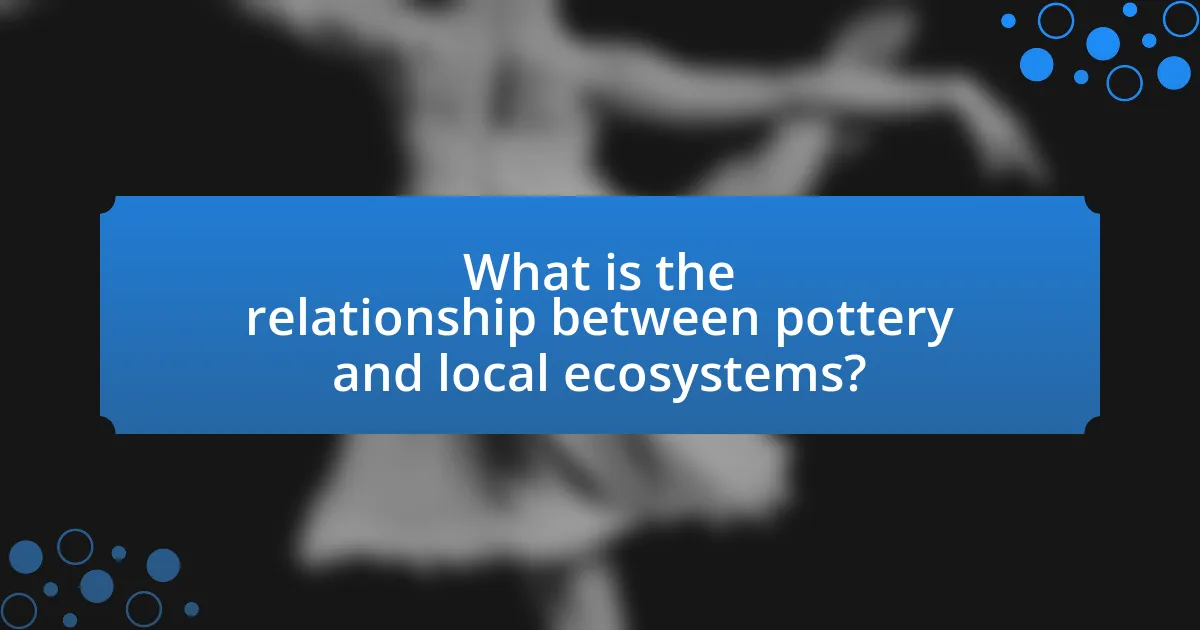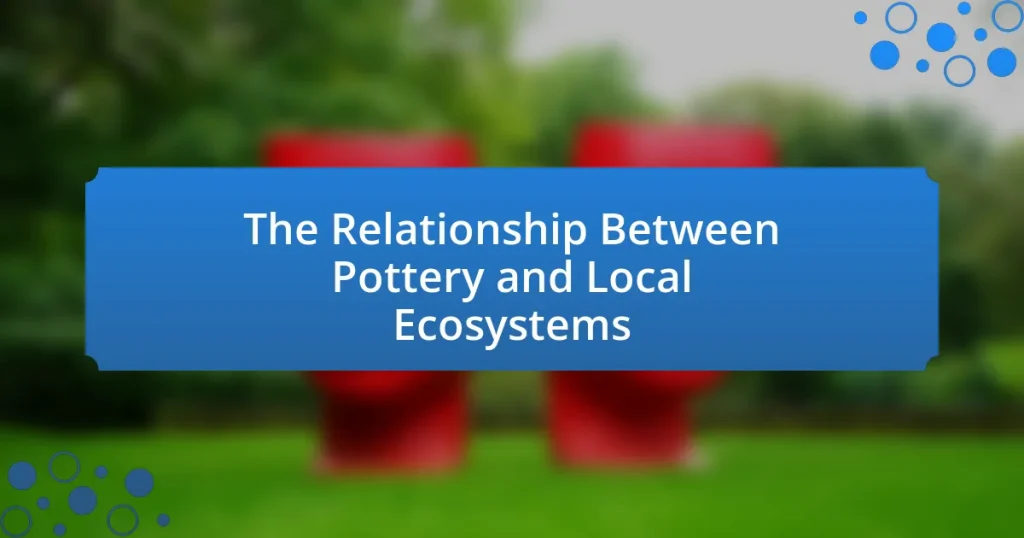The article examines the intricate relationship between pottery and local ecosystems, highlighting how pottery production impacts environmental sustainability through the sourcing of raw materials like clay, feldspar, and silica. It discusses the ecological consequences of clay extraction, including habitat destruction and biodiversity loss, as well as the energy consumption associated with firing processes. The article emphasizes the importance of sustainable pottery practices that utilize local resources and minimize waste, thereby fostering a symbiotic relationship between artisans and their environments. Additionally, it explores how traditional pottery techniques can contribute to ecological conservation and cultural heritage, ultimately advocating for responsible sourcing and environmentally friendly production methods.

What is the relationship between pottery and local ecosystems?
Pottery and local ecosystems are interconnected through the sourcing of raw materials and the impact of pottery production on environmental sustainability. Pottery typically requires clay, which is often extracted from local soil, influencing the landscape and ecosystem dynamics. For instance, the extraction process can lead to soil erosion and habitat disruption if not managed sustainably. Additionally, traditional pottery practices often incorporate local resources, such as water and organic materials, which can affect local biodiversity. Research indicates that sustainable pottery practices can enhance ecosystem health by promoting the use of local materials and minimizing waste, thereby fostering a symbiotic relationship between artisans and their environments.
How does pottery influence local environmental conditions?
Pottery influences local environmental conditions primarily through the extraction of clay and the energy consumption during firing processes. The extraction of clay can lead to soil degradation and habitat disruption, affecting local biodiversity. Additionally, the firing of pottery often requires significant energy, which can contribute to air pollution and greenhouse gas emissions if fossil fuels are used. For instance, traditional pottery kilns emit particulate matter and carbon dioxide, impacting air quality and contributing to climate change. Studies have shown that regions with high pottery production may experience altered land use patterns and increased deforestation, further affecting local ecosystems.
What materials are commonly used in pottery and how do they interact with the ecosystem?
Common materials used in pottery include clay, feldspar, and silica. Clay, primarily sourced from the earth, is a natural material that can be abundant in local ecosystems, often found in riverbanks and lakebeds. Its extraction can disrupt local habitats, but when sourced sustainably, it can be a renewable resource. Feldspar, a mineral that helps in the vitrification process during firing, is typically mined, which can lead to habitat destruction if not managed properly. Silica, derived from sand, is also mined and can contribute to soil erosion and habitat loss. The interaction of these materials with ecosystems is significant; sustainable practices in sourcing and using these materials can minimize environmental impact, while unsustainable practices can lead to degradation of local habitats and biodiversity loss.
How does the production of pottery affect local biodiversity?
The production of pottery can negatively affect local biodiversity by depleting natural resources and disrupting ecosystems. The extraction of clay and other raw materials often leads to habitat destruction, soil erosion, and loss of vegetation, which are critical for maintaining diverse species. For instance, studies have shown that mining clay can result in the degradation of surrounding habitats, leading to a decline in local flora and fauna. Additionally, the pollution generated during pottery production, such as waste runoff and emissions, can further harm local ecosystems by contaminating water sources and affecting air quality, which in turn impacts the health of various species.
Why is understanding this relationship important?
Understanding the relationship between pottery and local ecosystems is important because it reveals how cultural practices influence environmental sustainability. Pottery production often relies on local materials, which can affect resource management and biodiversity. For instance, the extraction of clay and other natural resources can lead to habitat degradation if not done sustainably. Additionally, traditional pottery techniques may promote the use of local flora and fauna, fostering a deeper connection between communities and their environments. This relationship highlights the need for sustainable practices that balance cultural heritage with ecological health, as evidenced by studies showing that sustainable pottery practices can enhance local biodiversity and resource conservation.
What role does pottery play in cultural heritage and environmental sustainability?
Pottery serves as a vital component of cultural heritage by preserving traditional craftsmanship and reflecting the identity of communities. This art form often embodies historical practices and local narratives, showcasing unique styles and techniques passed down through generations. Additionally, pottery contributes to environmental sustainability by utilizing locally sourced materials, such as clay, which minimizes transportation emissions and promotes the use of natural resources. The production of pottery can also encourage sustainable practices, such as recycling and the use of eco-friendly glazes. For instance, studies have shown that traditional pottery techniques often align with sustainable land management practices, fostering a symbiotic relationship between artisans and their local ecosystems.
How can pottery practices contribute to ecological conservation?
Pottery practices can contribute to ecological conservation by promoting the use of sustainable materials and techniques that minimize environmental impact. For instance, artisans often utilize locally sourced clay and natural pigments, reducing the carbon footprint associated with transportation and industrial production. Additionally, traditional pottery methods, such as wood firing, can utilize renewable resources and create less waste compared to mass production processes. Research indicates that these practices not only preserve local biodiversity by encouraging the use of native materials but also foster community engagement in conservation efforts, as seen in various cultural heritage projects worldwide.

What are the ecological impacts of pottery production?
Pottery production has significant ecological impacts, primarily through resource extraction, energy consumption, and waste generation. The extraction of clay and other raw materials can lead to habitat destruction, soil erosion, and depletion of local resources. For instance, mining clay can disrupt local ecosystems and reduce biodiversity. Additionally, the firing process in pottery production requires substantial energy, often derived from fossil fuels, contributing to greenhouse gas emissions. A study by the United Nations Environment Programme highlights that traditional pottery kilns can emit pollutants, affecting air quality and surrounding environments. Furthermore, the disposal of ceramic waste can lead to land pollution, as ceramics are not biodegradable and can persist in landfills for extended periods.
How does clay extraction affect local habitats?
Clay extraction negatively impacts local habitats by disrupting ecosystems, altering landforms, and affecting biodiversity. The removal of clay often leads to habitat destruction, as the extraction process can strip vegetation and disturb soil layers, which are crucial for local flora and fauna. Studies have shown that areas subjected to clay mining experience a decline in species richness and abundance due to habitat fragmentation and the introduction of pollutants. For instance, research published in the Journal of Environmental Management indicates that clay extraction sites can lead to a 30% reduction in local biodiversity compared to undisturbed areas. This evidence highlights the significant ecological consequences of clay extraction on local habitats.
What are the consequences of unsustainable clay mining practices?
Unsustainable clay mining practices lead to significant environmental degradation, including habitat destruction, soil erosion, and water pollution. These practices disrupt local ecosystems by removing vegetation and altering landforms, which can result in loss of biodiversity. For instance, the extraction of clay often involves stripping away topsoil, which is essential for plant growth and maintaining soil health. Additionally, runoff from mining sites can contaminate nearby water sources with heavy metals and other pollutants, adversely affecting aquatic life and local communities that rely on these water sources for drinking and agriculture. Studies have shown that regions with intensive clay mining experience a decline in species richness and ecosystem services, highlighting the long-term consequences of such practices on both the environment and human livelihoods.
How can responsible sourcing of materials mitigate ecological damage?
Responsible sourcing of materials can mitigate ecological damage by ensuring that raw materials are obtained in a sustainable manner, which reduces habitat destruction and pollution. For example, sourcing clay from local deposits minimizes transportation emissions and supports local economies, while also preserving the surrounding ecosystem. Studies indicate that sustainable practices, such as using recycled materials or responsibly harvested natural resources, can significantly lower the carbon footprint and reduce waste. Furthermore, adhering to regulations and certifications for sustainable sourcing helps protect biodiversity and promotes the health of local ecosystems, as evidenced by initiatives that have successfully restored habitats in areas previously affected by unsustainable extraction practices.
What are the environmental benefits of pottery?
Pottery offers several environmental benefits, primarily through its use of natural materials and sustainable practices. The production of pottery typically involves clay, which is abundant and biodegradable, reducing reliance on synthetic materials that contribute to pollution. Additionally, pottery can promote local economies by encouraging the use of locally sourced materials, thereby minimizing transportation emissions. Furthermore, traditional pottery techniques often require less energy compared to industrial manufacturing processes, leading to a lower carbon footprint. Studies indicate that artisanal pottery can enhance biodiversity by supporting local ecosystems through sustainable harvesting practices.
How does pottery promote the use of local resources?
Pottery promotes the use of local resources by utilizing locally sourced clay, minerals, and natural materials for its creation. This practice encourages communities to engage with their immediate environment, fostering sustainable extraction and use of these resources. For instance, traditional pottery techniques often rely on specific types of clay found in the region, which not only reduces transportation costs but also minimizes the carbon footprint associated with sourcing materials from distant locations. Additionally, the incorporation of local designs and cultural motifs in pottery strengthens community identity and supports local artisans, thereby enhancing the economic viability of using local resources.
In what ways can pottery contribute to waste reduction and recycling?
Pottery contributes to waste reduction and recycling by utilizing natural materials and promoting sustainable practices. The production of pottery often involves the use of clay, which is abundant and can be sourced locally, minimizing transportation waste. Additionally, pottery can be made from recycled materials, such as broken ceramics or glass, which reduces landfill waste and encourages the repurposing of materials. Studies show that incorporating recycled content in pottery can significantly lower the environmental impact of ceramic production, as it decreases the need for virgin materials and reduces energy consumption during manufacturing. Furthermore, pottery can serve as a durable alternative to single-use items, thereby decreasing overall waste generation in communities.

How can pottery practices be aligned with ecosystem health?
Pottery practices can be aligned with ecosystem health by utilizing sustainable materials and methods that minimize environmental impact. For instance, using locally sourced clay reduces transportation emissions and supports local economies, while employing non-toxic glazes prevents harmful chemicals from leaching into the soil and waterways. Research indicates that traditional pottery techniques, which often incorporate natural materials and low-energy firing methods, can enhance soil health and biodiversity. A study published in the Journal of Environmental Management highlights that sustainable pottery practices contribute to ecosystem resilience by promoting the use of renewable resources and reducing waste.
What sustainable practices can potters adopt?
Potters can adopt several sustainable practices, including using locally sourced clay, recycling water, and utilizing energy-efficient kilns. By sourcing clay from local deposits, potters reduce transportation emissions and support local economies. Recycling water in the studio minimizes waste and conserves this vital resource, as pottery production can be water-intensive. Additionally, energy-efficient kilns, such as those powered by renewable energy sources, significantly lower carbon footprints compared to traditional kilns. These practices not only enhance environmental sustainability but also promote a more responsible relationship between pottery and local ecosystems.
How can potters minimize their carbon footprint during production?
Potters can minimize their carbon footprint during production by utilizing energy-efficient kilns and sourcing local materials. Energy-efficient kilns, such as those that use renewable energy sources like solar or wind, significantly reduce greenhouse gas emissions compared to traditional gas or electric kilns. Additionally, sourcing clay and other materials locally decreases transportation emissions, as materials do not need to be shipped over long distances. Research indicates that local sourcing can cut transportation-related carbon emissions by up to 50%, thereby contributing to a lower overall carbon footprint in pottery production.
What techniques can be used to enhance the ecological benefits of pottery?
Techniques to enhance the ecological benefits of pottery include using sustainable materials, implementing energy-efficient firing methods, and promoting local sourcing of clay. Sustainable materials, such as recycled or natural clays, reduce environmental impact by minimizing resource extraction. Energy-efficient firing methods, like using solar kilns or alternative fuels, decrease carbon emissions associated with traditional firing processes. Additionally, sourcing clay locally supports local economies and reduces transportation emissions, further contributing to ecological sustainability. These practices collectively improve the environmental footprint of pottery production and align with ecological conservation efforts.
What are some examples of successful pottery and ecosystem integration?
Successful pottery and ecosystem integration can be observed in the practices of indigenous communities, such as the Pueblo peoples of the American Southwest, who utilize local clay and natural resources to create pottery that reflects their environment. This integration is evident in their use of natural pigments derived from local minerals and plants, which not only enhances the aesthetic value of their pottery but also promotes sustainable harvesting practices. Additionally, the use of traditional firing techniques, such as pit firing, minimizes environmental impact and utilizes available resources efficiently. These practices demonstrate a harmonious relationship between pottery production and the surrounding ecosystem, ensuring both cultural preservation and ecological sustainability.
How have communities successfully combined pottery with ecological initiatives?
Communities have successfully combined pottery with ecological initiatives by utilizing sustainable materials and practices in pottery production. For instance, some artisans use locally sourced clay and natural pigments, reducing transportation emissions and promoting local economies. Additionally, initiatives like the “Pottery for the Planet” program in the UK encourage potters to create eco-friendly products, such as biodegradable glazes, which minimize environmental impact. These practices not only foster environmental stewardship but also enhance community awareness about sustainability, as evidenced by increased participation in local workshops focused on eco-conscious pottery techniques.
What lessons can be learned from these successful integrations?
Successful integrations of pottery within local ecosystems demonstrate the importance of sustainable practices and community involvement. These integrations highlight that utilizing local materials reduces environmental impact and fosters a sense of ownership among artisans. For instance, studies show that pottery made from locally sourced clay not only supports the local economy but also minimizes transportation emissions, reinforcing the connection between craft and ecology. Furthermore, successful collaborations between potters and environmental organizations have led to the preservation of traditional techniques that respect ecological balance, illustrating that cultural heritage can coexist with environmental stewardship.
What practical tips can potters follow to support local ecosystems?
Potters can support local ecosystems by using locally sourced materials, which reduces transportation emissions and promotes regional biodiversity. By selecting clay and glazes from nearby suppliers, potters help sustain local economies and minimize environmental impact. Additionally, implementing sustainable practices such as recycling water used in the pottery process and utilizing energy-efficient kilns can further enhance ecological benefits. Research indicates that sustainable pottery practices can significantly reduce carbon footprints, contributing positively to local ecosystems.


